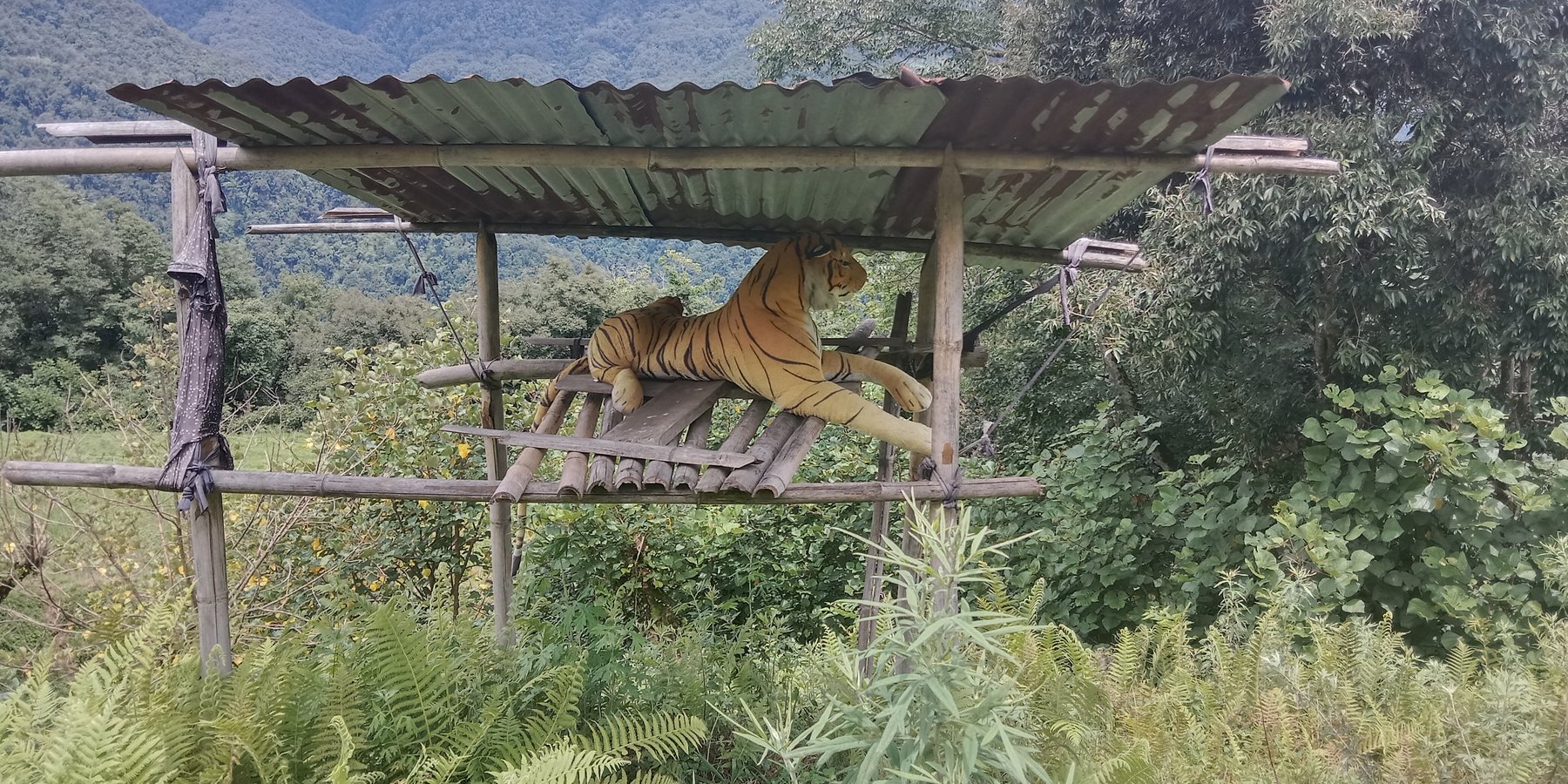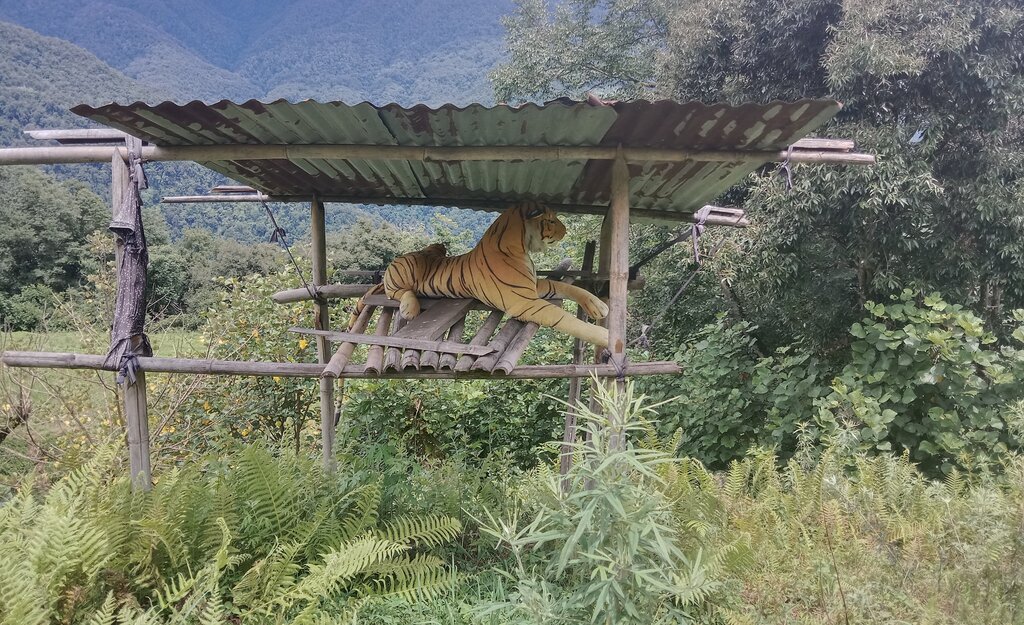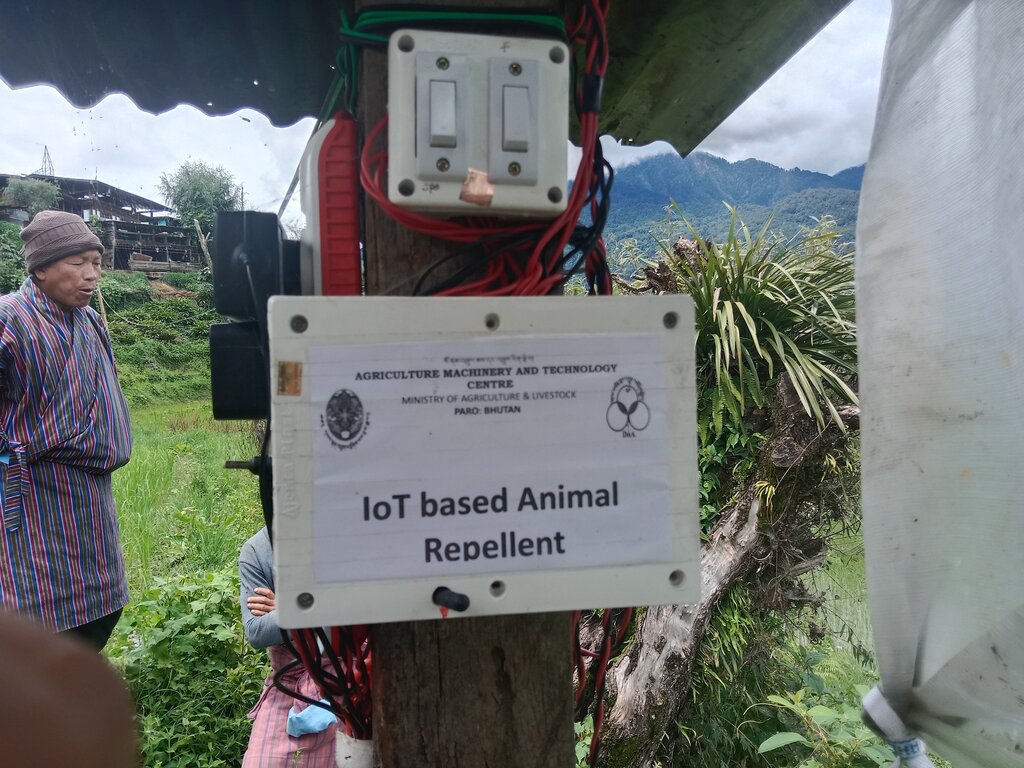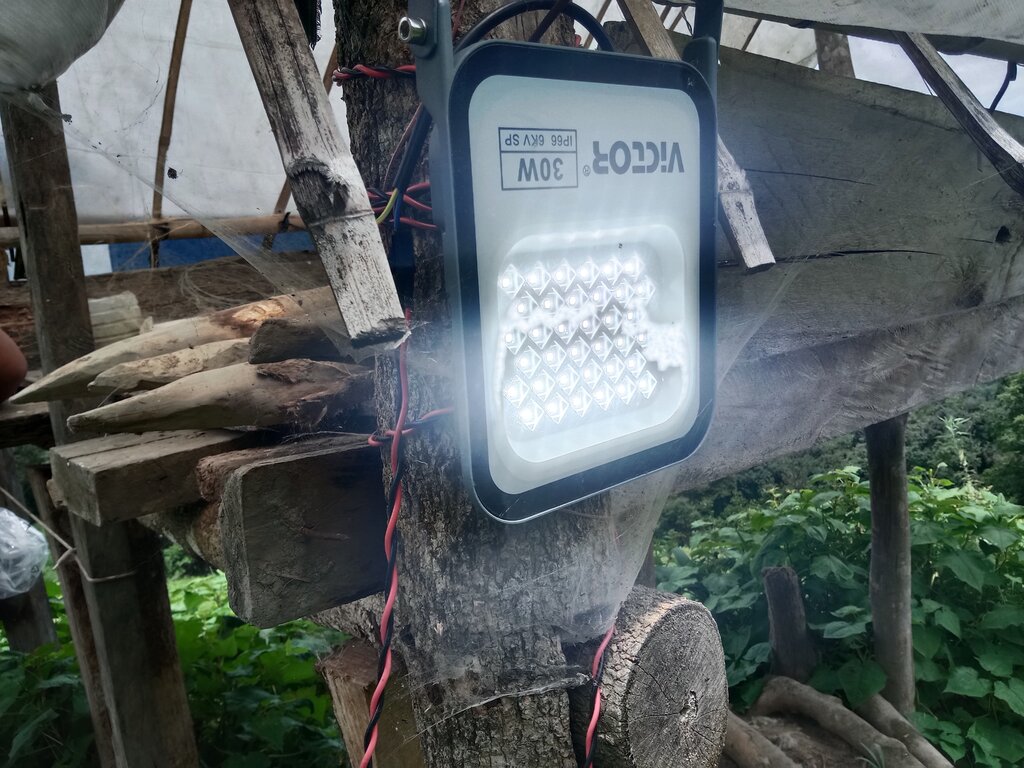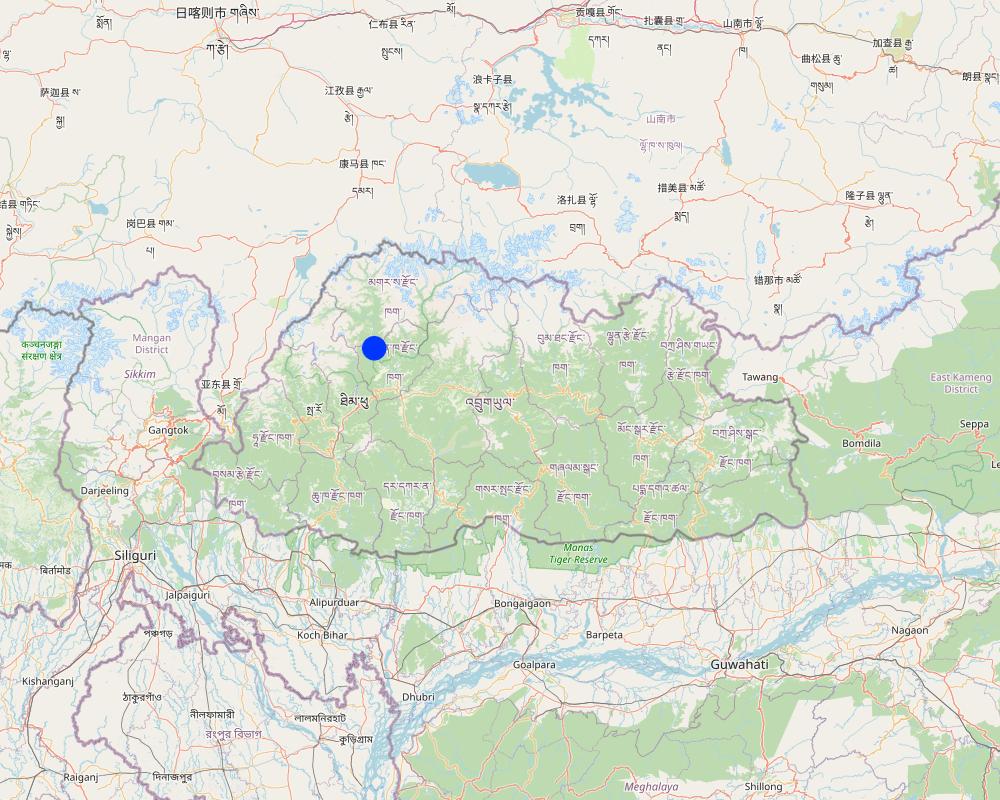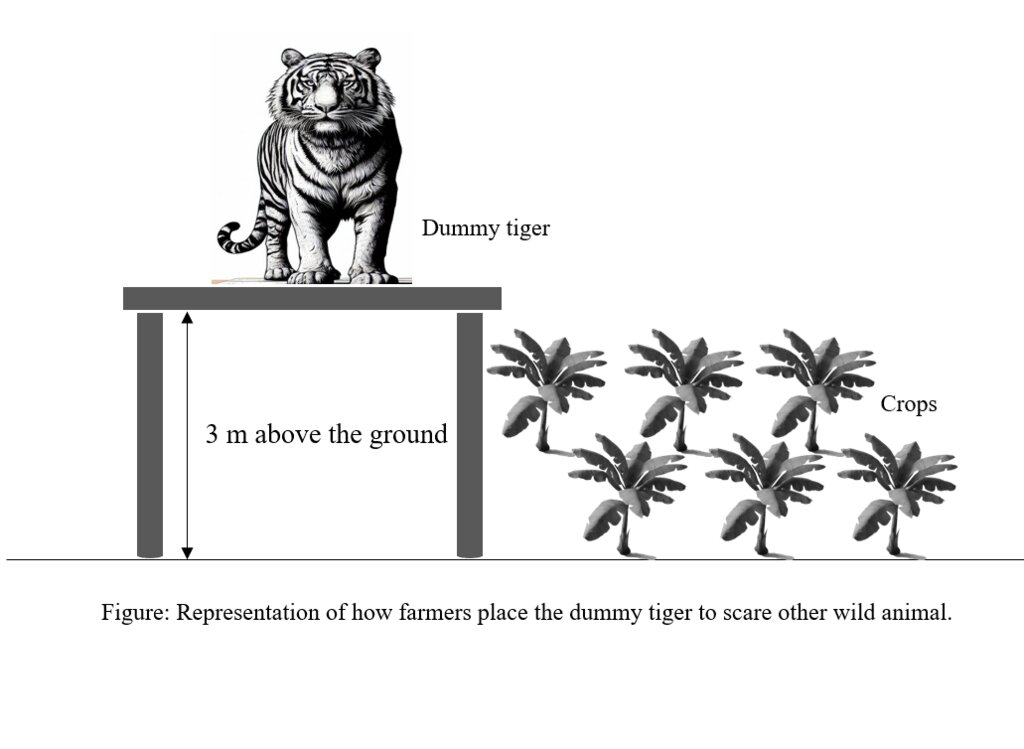Use of Dummy Tigers to Repel Wild Animals [Butão]
- Criação:
- Atualização:
- Compilador/a: Tshering Yangzom
- Editor: chenga Tshering
- Revisores: Rima Mekdaschi Studer, William Critchley, Joana Eichenberger
Tag Zuenma Laglen Thabtey Lothog Sungni (སྟག་རྫུན་མ་ལག་ལེན་འཐབ་སྟེ་ལོ་ཐོག་སྲུང་ནི།)
technologies_6860 - Butão
Veja as seções
Expandir tudo Recolher tudo1. Informação geral
1.2 Detalhes do contato das pessoas capacitadas e instituições envolvidas na avaliação e documentação da tecnologia
Pessoa(s) capacitada(s)
usuário de terra:
Tshering
Drochukha Chiwog (Community), Goenshari Gewog (Block), Punakha Dzongkhag (District)
Butão
usuário de terra:
Tshering Kinley
Drochukha Chiwog (Community), Goenshari Gewog (Block), Punakha Dzongkhag (District)
Butão
usuário de terra:
Dorji Kinzang
Drochukha Chiwog (Community), Goenshari Gewog (Block), Punakha Dzongkhag (District)
Butão
usuário de terra:
Tenzin Namgay
Drochukha Chiwog (Community), Goenshari Gewog (Block), Punakha Dzongkhag (District)
Butão
usuário de terra:
Kinzang
Drochukha Chiwog (Community), Goenshari Gewog (Block), Punakha Dzongkhag (District)
Butão
usuário de terra:
Tshering Gyeltshen
Drochukha Chiwog (Community), Goenshari Gewog (Block), Punakha Dzongkhag (District)
Butão
usuário de terra:
Lhamo Dorji
Drochukha Chiwog (Community), Goenshari Gewog (Block), Punakha Dzongkhag (District)
Butão
Especialista em GST:
Gyeltshen Tshewang
Gewog Agriculture Office, Goenshari Gewog (Block), Punakha Dzongkhag (District)
Butão
Nome do projeto que facilitou a documentação/avaliação da Tecnologia (se relevante)
Strengthening national-level institutional and professional capacities of country Parties towards enhanced UNCCD monitoring and reporting – GEF 7 EA Umbrella II (GEF 7 UNCCD Enabling Activities_Umbrella II)Nome da(s) instituição(ões) que facilitou(ram) a documentação/ avaliação da Tecnologia (se relevante)
National Soil Services Center, Department of Agric (National Soil Services Center, Department of Agric) - Butão1.3 Condições em relação ao uso da informação documentada através de WOCAT
O/a compilador/a e a(s) pessoa(s) capacitada(s) aceitam as condições relativas ao uso de dados documentados através da WOCAT:
Sim
1.4 Declaração de sustentabilidade da tecnologia descrita
A tecnologia descrita aqui é problemática em relação a degradação da terra de forma que não pode ser declarada uma tecnologia de gestão sustentável de terra?
Não
Comentários:
As per the responses, the use of a dummy tiger in guarding crops do not seem to have having direct role in mitigating land degradation. However, it can be claimed as a part of SLM technologies because it protects the crops from wild animals. Standing crops in the field is important to prevent erosion (both soil and water), add nitrogen to the soil (e.g., by leguminous crops), and for nutrient cycling. Also, the use of toy tiger prevents the land user from resorting to fatal methods of crop guarding that necessitates the killing of wildlife.
2. Descrição da tecnologia de GST
2.1 Descrição curta da tecnologia
Definição da tecnologia:
Dummy tigers are used to scare off crop predators. This can be considered a SLM technology because it protects the crops from wild animals which in turn prevents erosion (both soil and water), adds nitrogen to the soil (i.e., by leguminous crops), and helps in nutrient cycling. Furthermore, time is freed up for the farmer to carry out other SLM activities.
2.2 Descrição detalhada da tecnologia
Descrição:
In the region of Drochukha, Bhutan, the foremost challenge faced by rural communities is crops damage by wildlife. Land users in this area contend with damage inflicted by a variety of wild animals, including wild boar, barking deer, sambar deer, monkeys, porcupines, bears, and rats. To mitigate crop damage by wildlife, the land users of Drochukha have implemented a unique solution by strategically placing dummy tigers to deter these animals and safeguard their crops.
In 2018, a woman from Drochukha initiated the idea of using dummy tigers to protect crops, and it proved to be highly successful. Following this, other residents also adopted the practice. Farmlands situated near the forest's periphery experience the most significant crop damage by wild animals. By placing dummy tigers near the forest's edge, the land users have not only reduced wildlife attacks in the peripheral regions but also significantly decreased such incidents in the central areas. To protect their crops from wild animals, they procured a dummy tiger at a cost of Nu. 3,380 (about USD 40) from Bajo town in Wangduephodrang Dzongkhag and another dummy tiger costing Nu. 2,000 (about USD 25) from the Indian market in Jaigaon. The land users constructed a raised wooden platform by placing four wooden poles in the ground and adding planks over them to support the dummy tigers, ensuring that they faced the forest.
The implementation of dummy tigers (two) has yielded numerous benefits for 21 households in the region. With the adoption of this innovative approach, Drochukha farmers have been able to increase their crop production and rejuvenate previously unused lands. Dummy tigers effectively safeguard standing crops and prevent wildlife depredation. Maintaining standing crops in the fields is essential to prevent erosion, both of soil and water, while also contributing nitrogen to the soil through the cultivation of leguminous crops and facilitating nutrient cycling. An important aspect of employing dummy tigers is that it prevents land users from resorting to fatal methods of crop protection that may involve the killing of wildlife. Human-wildlife conflicts have thus been reduced. The primary current concern of the land users of Drochukha is the fading colour of the dummy tigers, and they are eager for improved interventions that may involve mobile and sound-producing tigers.
The Agriculture Machinery Centre (AMC) and the Dzongkhag Agriculture Office (DAO) have joined forces to create an IoT-based animal-repellent system. This system, positioned at the field's periphery, comprises three primary components: a speaker, a receptor card, and an amplifier. Once connected to an owner's smartphone, the system allows for the remote playback of various animal sounds. One system, consisting of a single receptor card, can be linked to up to five users. Additionally, two LED flashlights are integrated into the system to deter wild boars at night through powerful pulse flashes. The complete system comes at a cost of Nu. 30,000. Moreover, in their most recent endeavors, AMC and DAO are currently developing a robotic tiger capable of moving its head and limbs, enabling it to patrol the guardhouse and serve as a further deterrent to wildlife. The technology is being piloted as a project to evaluate its effectiveness in the field through trials.
2.3 Fotos da tecnologia
Observações gerais sobre as fotos:
The IoT-based animal-repellent system is one of the promising technologies that evolved with the need to guard the field in the absence of humans.
2.5 País/região/locais onde a tecnologia foi aplicada e que estão cobertos nesta avaliação
País:
Butão
Região/Estado/Província:
Drochukha Chiwog, Goenshari Gewog, Punakha Dzongkhag
Especifique a difusão da tecnologia:
- Aplicado em pontos específicos/concentrado numa pequena área
O(s) local(is) tecnológico(s) está(ão) localizado(s) em uma área permanentemente protegida?
Sim
Caso afirmativo, especifique:
The area falls under Jigme Dorji National Park (JDNP). The park is one of the oldest protected areas in Bhutan. Endowed with a high number of endangered plants and animals supported by a huge range of vegetation types and climatic regimes, JDNP is undoubtedly the conservation jewel in the Eastern Himalayas. It is also the treasure trove of medicinal plants, natural hot springs, medicinal waters, and jaw-dropping sceneries, unparalleled in the country.
Map
×2.6 Data da implementação
Indique o ano de implementação:
2018
2.7 Introdução da tecnologia
Especifique como a tecnologia foi introduzida:
- atráves de inovação dos usuários da terra
Comentários (tipos de projeto, etc.):
A lady named Dorji Lhamo of the community, originally from Mongar (Eastern Bhutan) has seen some tiger toys placed at the field peripheries to scare away the wild animals while making her visit to her native village. With much curiosity, she tried doing the same thing in Drochukha (Western Bhutan) where she currently lives. It worked, especially in scaring monkeys away.
3. Classificação da tecnologia de GST
3.1 Principal/principais finalidade(s) da tecnologia
- Melhora a produção
- Preserva ecossistema
- Criar impacto econômico benéfico
- Cria impacto social benéfico
3.2 Tipo(s) atualizado(s) de uso da terra onde a tecnologia foi aplicada
Uso do solo misturado dentro da mesma unidade de terra:
Sim
Especificar o uso misto da terra (culturas/ pastoreio/ árvores):
- Agrofloresta

Terra de cultivo
- Cultura anual
- Cultura perene (não lenhosa)
- Cultura de árvores e arbustos
Cultivo anual - Especificar culturas:
- cereais - cevada
- cereais - milho
- cereais - arroz (zona húmida)
- cereais - trigo (inverno)
Cultivo perene (sem lã) - Especificar culturas:
- banana/planta/abacá
- ervas, pimentão, capsicum
Cultivo de árvores e arbustos - Especificar culturas:
- abacate
- cítrico
Número de estações de cultivo por ano:
- 1
O cultivo entre culturas é praticado?
Sim
Em caso afirmativo, especifique quais são as culturas intercultivadas:
Vegetables are intercropped.
O rodízio de culturas é praticado?
Sim
Caso afirmativo, especifique:
Vegetables are rotated.

Floresta/bosques
- Florestas/bosques (semi)naturais
Florestas (semi)naturais/ bosques: Especificar o tipo de manejo:
- Derrubada seletiva
- Uso florestal não madeireiro
As árvores especificadas acima são decíduas ou perenes?
- decíduas mistas/perene
Produtos e serviços:
- Madeira
- Lenha
- Outros produtos florestais
3.3 O uso do solo mudou devido à implementação da Tecnologia?
O uso do solo mudou devido à implementação da Tecnologia?
- Não (Continuar com a pergunta 3.4)
3.4 Abastecimento de água
Abastecimento de água para a terra na qual a tecnologia é aplicada:
- Misto de precipitação natural-irrigado
Comentários:
The community has two irrigation sources, Khaow Lum benefiting 6 households, and Jaga Lum benefiting all 21 households.
3.5 Grupo de GST ao qual pertence a tecnologia
- Human-wildlife conflict management
3.6 Medidas de GST contendo a tecnologia

Medidas estruturais
- S11: Outros
Comentários:
This SLM technology would fall under the structure category as it requires a simple structural wooden stand to place the tiger toys.
3.7 Principais tipos de degradação da terra abordados pela tecnologia

Erosão do solo pela água
- Wt: Perda do solo superficial/erosão de superfície

Erosão do solo pelo vento
- Et: Perda do solo superficial

Degradação biológica
- Bc: redução da cobertura vegetal
Comentários:
Based on the responses, it appears that the utilization of toy tiger decoys for crop protection may not be directly associated with mitigating land degradation. Nevertheless, it can be considered a component of Sustainable Land Management (SLM) technologies since it serves to safeguard crops from wildlife damage. Preserving standing crops in fields holds significance in preventing erosion, both in terms of soil and water. Furthermore, standing crops contribute to soil enrichment by introducing nitrogen (e.g., through leguminous crops) and facilitate nutrient cycling. Another crucial aspect is that the toy tigers effectively deter wildlife from preying on crops, and they also aid in repelling vertebrate pests from fields.
3.8 Redução, prevenção ou recuperação da degradação do solo
Especifique o objetivo da tecnologia em relação a degradação da terra:
- Prevenir degradação do solo
- Reduzir a degradação do solo
Comentários:
Based on the responses, it seems that the use of toy tigers may not directly address land degradation. However, it can be categorized as a component of Sustainable Land Management (SLM) technologies because it plays a role in protecting crops from wildlife damage. Maintaining standing crops in fields is essential for erosion prevention, both in terms of soil and water conservation. Additionally, it contributes to soil enrichment by introducing nitrogen, especially through the cultivation of leguminous crops, and supports nutrient cycling. Another significant aspect is that toy tigers effectively serve as a deterrent against wildlife crop depredation and help in repelling vertebrate pests from fields
4. Especificações técnicas, implementação de atividades, entradas e custos
4.1 Desenho técnico da tecnologia
Especificações técnicas (relacionada ao desenho técnico):
The tiger toys are placed 3 meters above the ground. To ensure stability, the toys are placed on the planks supported by strong poles.
Autor:
Ongpo Lepcha
Data:
11/12/2023
4.2 Informação geral em relação ao cálculo de entradas e custos
Especifique como custos e entradas foram calculados:
- Por unidade de tecnologia
Outro/moeda nacional (especifique):
Nu.
Se for relevante, indique a taxa de câmbio do USD para moeda local (por exemplo, 1 USD = 79,9 Real): 1 USD =:
80,0
Indique a média salarial da mão-de-obra contratada por dia:
800
4.3 Atividades de implantação
| Atividade | Periodicidade (estação do ano) | |
|---|---|---|
| 1. | Procurement of tiger toys. | Before cropping season |
| 2. | Construction of guard houses using any available materials to place the tiger toys. | Before cropping season |
| 3. | Placing the tiger toys. | Cropping season |
Comentários:
The need for repainting the faded colours and the lack of movement of the tiger toys are the shortcomings associated with this technology.
4.4 Custos e entradas necessárias para a implantação
| Especifique a entrada | Unidade | Quantidade | Custos por unidade | Custos totais por entrada | % dos custos arcados pelos usuários da terra | |
|---|---|---|---|---|---|---|
| Mão-de-obra | Labor | man/day | 1,0 | 800,0 | 800,0 | 100,0 |
| Outros | Tiger toy | No. | 1,0 | 3380,0 | 3380,0 | 100,0 |
| Outros | Tiger toy | No. | 1,0 | 2000,0 | 2000,0 | 100,0 |
| Custos totais para a implantação da tecnologia | 6180,0 | |||||
| Custos totais para o estabelecimento da Tecnologia em USD | 77,25 | |||||
Comentários:
The current costing is being done based on the local market value of tiger toys. As per the respondents, the tiger toy of the required size cost Nu. 3380 from the local market (Wangdi Phodrang), whereas the same tiger cost Nu. 2000 from the Indian (Jaigoan) market.
4.5 Atividades recorrentes/manutenção
Comentários:
Since the adoption began in 2018, no maintenance, including the replacement of tiger toys, has been necessary. However, in the upcoming years, maintenance may become necessary due to the fading color of the tiger toys.
4.6 Custos e entradas necessárias pata a manutenção/atividades recorrentes (por ano)
Se você não conseguir discriminar os custos na tabela acima, forneça uma estimativa dos custos totais de manutenção da Tecnologia:
5346,0
Comentários:
Buying two new dummy tigers as replacements would cost approximately 66 USD (Nu. 5346) on the higher pricing end and around 50 USD (Nu. 4050) on the lower pricing end.
5. Ambiente natural e humano
5.1 Clima
Precipitação pluviométrica anual
- <250 mm
- 251-500 mm
- 501-750 mm
- 751-1.000 mm
- 1.001-1.500 mm
- 1.501-2.000 mm
- 2.001-3.000 mm
- 3.001-4.000 mm
- > 4.000 mm
Zona agroclimática
- Semiárido
Dry sub tropical
5.2 Topografia
Declividade média:
- Plano (0-2%)
- Suave ondulado (3-5%)
- Ondulado (6-10%)
- Moderadamente ondulado (11-15%)
- Forte ondulado (16-30%)
- Montanhoso (31-60%)
- Escarpado (>60%)
Formas de relevo:
- Planalto/planície
- Cumes
- Encosta de serra
- Encosta de morro
- Sopés
- Fundos de vale
Zona de altitude:
- 0-100 m s.n.m.
- 101-500 m s.n.m.
- 501-1.000 m s.n.m.
- 1.001-1.500 m s.n.m.
- 1.501-2.000 m s.n.m.
- 2.001-2.500 m s.n.m.
- 2.501-3.000 m s.n.m.
- 3.001-4.000 m s.n.m.
- > 4.000 m s.n.m.
Indique se a tecnologia é aplicada especificamente em:
- Não relevante
5.3 Solos
Profundidade do solo em média:
- Muito raso (0-20 cm)
- Raso (21-50 cm)
- Moderadamente profundo (51-80 cm)
- Profundo (81-120 cm)
- Muito profundo (>120 cm)
Textura do solo (solo superficial):
- Grosso/fino (arenoso)
- Médio (limoso, siltoso)
Textura do solo (>20 cm abaixo da superfície):
- Grosso/fino (arenoso)
- Médio (limoso, siltoso)
Matéria orgânica do solo superficial:
- Alto (>3%)
Caso disponível anexe a descrição completa do solo ou especifique as informações disponíveis, p. ex. tipo de solo, PH/acidez do solo, nitrogênio, capacidade de troca catiônica, salinidade, etc.
Moisture content-3.10%
Organic matter-7.08 %
Organic carbon-4.12%
pH-6.35
Electrical conductivity-181.33 µs/cm
Nitrogen-0.21
Phosphorus-0.21
Potassium-81.90 mg/100ml
Soil texture-Loamy sand
5.4 Disponibilidade e qualidade de água
Lençol freático:
5-50 m
Disponibilidade de água de superfície:
Bom
Qualidade da água (não tratada):
Água potável boa
A qualidade da água refere-se a:
água de superfície
A salinidade da água é um problema?
Não
Ocorre inundação da área?
Não
Comentários e outras especificações sobre a qualidade e a quantidade da água:
A landslide in the community was recorded in 1991, losing about one acre of land.
5.5 Biodiversidade
Diversidade de espécies:
- Alto
Diversidade de habitat:
- Alto
Comentários e outras especificações sobre biodiversidade:
The greater vegetation coverage at the outskirts of the community indicates a higher level of habitat and species biodiversity.
5.6 Características dos usuários da terra que utilizam a tecnologia
Sedentário ou nômade:
- Sedentário
Orientação de mercado do sistema de produção:
- misto (subsistência/comercial)
Rendimento não agrícola:
- 10-50% de toda renda
Nível relativo de riqueza:
- Média
Indivíduos ou grupos:
- Indivíduo/unidade familiar
Nível de mecanização:
- Trabalho manual
- Mecanizado/motorizado
Gênero:
- Mulheres
- Homens
Idade dos usuários da terra:
- Jovens
- meia-idade
Indique outras características relevantes dos usuários da terra:
The Drochukha community came into existence after their ancestors migrated to the current site from Gasa Dzongkhag some 50 years ago. Only 2 of 21 households are native.
5.7 Área média de terrenos utilizados pelos usuários de terrenos que aplicam a Tecnologia
- < 0,5 ha
- 0,5-1 ha
- 1-2 ha
- 2-5 ha
- 5-15 ha
- 15-50 ha
- 50-100 ha
- 100-500 ha
- 500-1.000 ha
- 1.000-10.000 ha
- > 10.000 ha
É considerado pequena, média ou grande escala (referente ao contexto local)?
- Média escala
Comentários:
The land holdings of the household in the community range from 1 - 5 acres, a mix of small-scale and large-scale as per the local context. The average land holding at the national level is 3 acres (1.2 ha)
In the local context:
3 acres (1.2 ha) = medium scale
> 3 acres = large-scale
<3 acres = small-scale
5.8 Propriedade de terra, direitos de uso da terra e de uso da água
- Family land
Direitos do uso da terra:
- Indivíduo
Direitos do uso da água:
- Comunitário (organizado)
- Indivíduo
Os direitos de uso da terra são baseados em um sistema jurídico tradicional?
Sim
Especifique:
The land use rights in Bhutan is based on a traditional legal system guided by formal land act and land rules and regulations.
5.9 Acesso a serviços e infraestrutura
Saúde:
- Pobre
- Moderado
- Bom
Educação:
- Pobre
- Moderado
- Bom
Assistência técnica:
- Pobre
- Moderado
- Bom
Emprego (p. ex. não agrícola):
- Pobre
- Moderado
- Bom
Mercados:
- Pobre
- Moderado
- Bom
Energia:
- Pobre
- Moderado
- Bom
Vias e transporte:
- Pobre
- Moderado
- Bom
Água potável e saneamento:
- Pobre
- Moderado
- Bom
Serviços financeiros:
- Pobre
- Moderado
- Bom
6. Impactos e declarações finais
6.1 Impactos no local mostrados pela tecnologia
Impactos socioeconômicos
Produção
Produção agrícola
Quantidade anterior à GST:
125kg
Quantidade posterior à GST:
250kg
Comentários/especificar:
Previously, farmers could only harvest approximately 125 kg of potatoes when planting 250 kg of seeds. Now, they can harvest nearly 1500 kg of potatoes from the same amount of seeds.
Renda e custos
Despesas com insumos agrícolas
Comentários/especificar:
Daytime crop guarding against monkeys is no longer necessary, allowing land users to allocate their time to other productive activities.
Rendimento agrícola
Comentários/especificar:
With no need for daytime crop guarding, land users can engage in off-farm activities, earning up to Nu. 800 per day. This has proven to be advantageous in increasing their overall farm income.
Diversidade de fontes de rendimento
Comentários/especificar:
Off-farm earning has become possible. Production and marketing of other seasonal crops and high-value crops are possible.
Carga de trabalho
Comentários/especificar:
The continuous daytime guarding is not required anymore.
Impactos socioculturais
Segurança alimentar/auto-suficiência
Comentários/especificar:
The land users can produce enough for self-consumption and commercialization.
Oportunidades culturais
Comentários/especificar:
The use of lethal methods for crop protection is no longer necessary, thus preventing the killing of wild animals
Impactos ecológicos
Biodiversidade: vegetação, animais
Controle de praga/doença
Comentários/especificar:
The control of vertebrate pests, especially monkeys, has been very successful.
6.2 Impactos externos mostrados pela tecnologia
Protection of farms further from the land users' farms
Comentários/especificar:
Toy tigers protect farms further from the land users' farms also. There is no intrusion of wild animals into the villages.
6.3 Exposição e sensibilidade da tecnologia às mudanças climáticas graduais e extremos/desastres relacionados ao clima (conforme o ponto de vista dos usuários da terra)
Mudança climática gradual
Mudança climática gradual
| Estação do ano | aumento ou diminuição | Como a tecnologia lida com isso? | |
|---|---|---|---|
| Temperatura anual | aumento | muito bem | |
| Precipitação pluviométrica anual | aumento | muito bem |
Extremos (desastres) relacionados ao clima
Desastres meteorológicos
| Como a tecnologia lida com isso? | |
|---|---|
| Temporal local | muito bem |
| Trovoada local | muito bem |
| Tempestade de granizo local | muito bem |
| Tempestade de vento local | muito bem |
Desastres climatológicos
| Como a tecnologia lida com isso? | |
|---|---|
| Condições de inverno extremo | muito bem |
Desastres biológicos
| Como a tecnologia lida com isso? | |
|---|---|
| Doenças epidêmicas | muito bem |
| Infestação de insetos/vermes | muito bem |
6.4 Análise do custo-benefício
Como os benefícios se comparam aos custos de implantação (do ponto de vista dos usuários da terra)?
Retornos a curto prazo:
muito positivo
Retornos a longo prazo:
muito positivo
Como os benefícios se comparam aos custos recorrentes/de manutenção(do ponto de vista dos usuários da terra)?
Retornos a curto prazo:
muito positivo
Retornos a longo prazo:
muito positivo
Comentários:
The technology is cost effective and every individual can afford it easily.
6.5 Adoção da tecnologia
- 11-50%
Se disponível, determine a quantidade (número de unidades familiares e/ou área abordada):
Out of the 21 households, 10 have embraced the technology. The reason for this is primarily that the remaining 11 households have their lands situated in the central part of the community and do not share boundaries with the forests.
De todos aqueles que adotaram a Tecnologia, quantos o fizeram espontaneamente, ou seja, sem receber nenhum incentivo/ pagamento material?
- 91-100%
Comentários:
The expenditures were borne by the farmers. No external funding was involved in buying tiger toys.
6.6 Adaptação
A tecnologia foi recentemente modificada para adaptar-se as condições variáveis?
Sim
Outros (especificar):
Modern technology integration
Especifique a adaptação da tecnologia (desenho, material/espécie, etc):
The Agriculture Machinery Centre (AMC) and the Dzongkhag Agriculture Office (DAO) have joined forces to create an IoT-based animal-repellent system. This system, positioned at the field's periphery, comprises three primary components: a speaker, a receptor card, and an amplifier. Once connected to a owner's smartphone, the system allows for the remote playback of various animal sounds. One system, consisting of a single receptor card, can be linked to up to five users. Additionally, two LED flashlights are integrated into the system to deter wild boars at night through powerful pulse flashes. The complete system comes at a cost of Nu. 30,000.
Moreover, in their most recent endeavors, AMC and DAO are currently developing a robotic tiger capable of moving its head and limbs, enabling it to patrol the guardhouse and serve as a further deterrent to wildlife. The technology is being piloted as a project to evaluate its effectiveness in the field through trials.
6.7 Pontos fortes/vantagens/oportunidades da tecnologia
| Pontos fortes/vantagens/oportunidades na visão do usuário da terra |
|---|
| The crop production is enhanced. |
| Lethal methods for crop protection have been avoided. |
| Overall farm income is increased after the adoption of technology. |
| Pontos fortes/vantagens/oportunidades na visão do/a compilador/a ou de outra pessoa capacitada |
|---|
| No major threats to the external environment and user friendly technology. |
| Tiger toy protects the crops from wild animals. Standing crops in the field is important to prevent erosion (both soil and water), add nitrogen to the soil (e.g., by leguminous crops), and for nutrient cycling. The other important aspect is toy tiger prevents wildlife depredation. |
6.8 Pontos fracos, desvantagens/riscos da tecnologia e formas de superá-los
| Pontos fracos/desvantagens/riscos na visão do usuário da terra | Como eles podem ser superados? |
|---|---|
| The colour fading of tiger toys could be a problem in the future. | Repaint toy tigers. |
| Financial burden on the land users. | Implement a cost-sharing mechanism. |
| Pontos fracos/vantagens/riscos na visão do/a compilador/a ou de outra pessoa capacitada | Como eles podem ser superados? |
|---|---|
| The wild animals especially the monkeys might get used to tiger toys. | A robotic tiger producing sounds in certain intervals would be the next best innovation, which is already under process. |
7. Referências e links
7.1 Métodos/fontes de informação
- visitas de campo, pesquisas de campo
7
- entrevistas com usuários de terras
7
- entrevistas com especialistas em GST
1
Quando os dados foram compilados (no campo)?
18/07/2023
7.3 Links para informações on-line relevantes
Título/ descrição:
Introduction – Jigme Dorji National Park
URL:
https://www.dofps.gov.bt/introduction-jigme-dorji-national-park/
Links e módulos
Expandir tudo Recolher tudoLinks
Não há links
Módulos
Não há módulos


